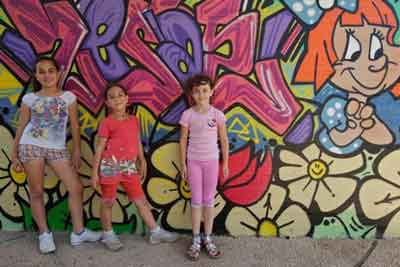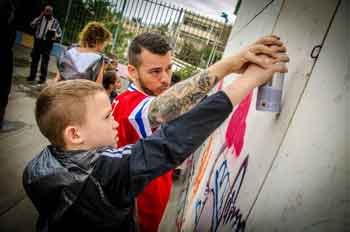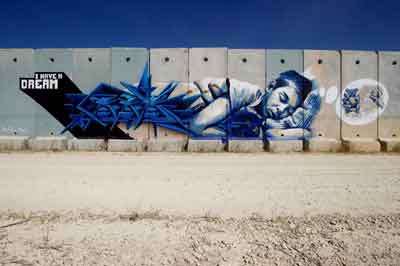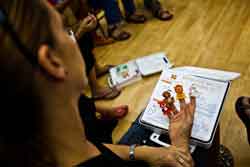Arts
Feature
Writing on the Wall

Last November, Newark street artist Getlostalot spray-painted his name on the gun of an abandoned Syrian tank in the Golan Heights.
Getlostalot who, like many other street artists, prefers to use his street name, or handle, participated in a mission to Israel dubbed Art Over War, sponsored by Artists 4 Israel, a fiercely pro-Israel education, advocacy, social service and artists’-rights organization. The group of eight international and five Israeli artists painted on the walls of the former hospital in Kuneitra, which Syrian troops had turned into a spy base and then destroyed; replaced hate-filled graffiti with messages of reconciliation; and hosted parties for children in Jerusalem and Tel Aviv. Nothing, says Getlostalot, 27, was left bare anywhere the group traveled. Many of the artists posted images on social media of the massive murals they produced, reaching thousands of followers.
“We do our part to combat violence around the world with a can and a vision,” says Getlostalot, whose handle means “if you get lost a lot you will find something you enjoy on your own without any other influence.” A4I’s goal is similar: It provides artists with the information and experience to make their own decisions about Israel and the Middle East—in effect, hasbara (public relations) through art. Since its founding in 2009, it has organized six trips to Israel and worked with over 6,000 Jewish and non-Jewish artists from around the world in a variety of projects: painting bomb shelters in Sderot and kindergartens on kibbutzim; painting with Ethiopian Yityish “Titi” Aynaw (Miss Israel 2013) and at the Knesset. In the United States, A4I has created murals on college campuses and designed a traveling Bomb Shelter Museum to simulate the experience for non-Israelis.

“We can’t stop the rockets but we can enhance the quality of life in Israel,” says cofounder and board member Tara Gordon, 31, a writer from New York who fell in love with Israel on a Young Judaea summer trip.
Though A4I works with artists in all media, it focuses on graffiti and street artists (usually non-Jewish males ages 18 to 35) whose “contemporary, urban and disruptive” works “produce beautiful, radical and effective advocacy initiatives,” according to the A4I website. “Graffiti art is the most democratic of art forms,” explains cofounder and executive director Craig Dershowitz, 37, former creative director of BOMBIN’, a graffiti magazine. “While most media [have] rules and judgments, and artists need materials and a gallery, graffiti art needs only a marker. A spray paint can is the highest form of supplies and the work can be seen by everyone at once.”
I’m trying to change the landscape—literally,” says Ski Mst, 35, a New York artist of Dominican and French heritage who went on two A4I trips. “I’m spreading my joy, my colors. I’m the guy who comes into town with bright blue and red. For a moment you are engulfed in a colorful piece of art and not thinking of conflict.”

The artists stress that politics is not their agenda—they are participating in a bonding experience for peace, joy and knowledge. “I wasn’t told to go pro-this or pro-that,” says Ski Mst.
But Dershowitz does not avoid controversy—he has taken groups behind the Green Line, where they once painted a depiction of the Third Temple at the suggestion of a Hasidic onlooker. Nor does he think it is possible to separate art from religion and politics. “I tell the artists, ‘If all you do is sneeze it will be interpreted in some way,’” he recalls. “We’ve been called leftist, rightist, sacrilegious and Orthodox. As long as I’m exciting such emotion, then I know that what I care about—my art—is being done.”
“We can’t escape politics—but we keep politics out of it,” Gordon says more diplomatically, noting that A4I works with all Israelis—Muslim, Christian and Jew—in all regions.
That mission took center stage during operation Protective Edge this past summer. In August, an A4I team distributed 200 Healing Arts Kits at southern kibbutzim and towns and trained professionals in their use. The kits, developed in partnership with art therapists, trauma specialists, artists and teachers, include activities and supplies for parents and children in and out of bomb shelters, such as bubbles, finger puppets, clay and drawing materials. “They are a positive coping distraction that provide comfort and reinforce play, resilience and empowerment,” explains Rena Grosser, 29, a Chicago artist and art therapist and one of the project’s developers. Children from the Manhattan Day School in New York and members of the Birthright Israel Alumni Community helped assemble the kits and sent drawings and messages.

The program, which officially launched this October in partnership with WIZO (Women’s International Zionist Organization), grew out of a March 2014 trip with a group of female graffiti artists to celebrate women’s freedoms in Israel. “We were in Ashdod during rocket attacks, and the artists said, ‘Let’s work with the kids to take their minds off it,’” Dershowitz recalls, adding that the concept for the kits was originally promoted by street artist Army of One (Jef Campion, who has since passed away).
Dershowitz notes that the trip exposes participants to an array of cultural, social and gender issues. At a Netanya community center with a mixed population of Russian and Ethiopian children, the artists painted the exterior walls with images of Russian nesting dolls and whimsical Ethiopian boys surrounded by people with purple skin tones so as not to represent one culture or another. “There are people of all colors in one small country,” says Gordon. “That’s a side most people don’t see.” On a shed in Ulpanat Dolev, a school for at-risk girls, Spanish artist Belin (Miguel Angel Belinchon Bujes), 35, created a portrait of a brown-eyed girl with long lashes whose race is unclear; she could be any Israeli—Sefardic Jew, Ethiopian, Arab. The teachers encouraged the girls to use the image as a model for being strong and proud, says Dershowitz.
“Inviting people to know how we live in Israel and sending them back to talk about it is great,” says Mas972, a 30-year-old Israeli artist from Tel Aviv who has painted his signature smiling animals with A4I in Netanya and in the Jordan Valley. Especially in low-income areas, “we do our best to give the population a boost not to fall into depression.” He participates eagerly in A4I’s work: “If we don’t do it for ourselves,” Mas972 says, “we can’t expect others to give to us.”
Avi Poch, a social worker in Jerusalem’s Baka neighborhood, contacted A4I to bring “a day of happiness” to the Zalman Aran School, which has a large underprivileged population. Artists helped children paint Hebrew letters and symbols of the 12 tribes to match nearby street names. That same day in a community event, parents repainted the whole school. “A choir welcomed the artists…. Big hulking artists with tattoos were crying because the kids were singing ‘Heveinu Shalom Aleikhem,’” he says. “A lot of communities don’t have access to art and culture. This allowed them to interact with world-class graffiti artists who showed them another way to look at the world.”
Outside israel, a4i’s successes range from bringing pro-Israel artists to Art Basel, the world’s second-largest art fair, to selling out a series of Off-Broadway plays. Recently, it cosponsored the inaugural Szyk Prize of Disruptive Thought and Zionist Art (awarded to Israeli artist Tomer Peretz). Some of the artists who visited Israel now travel to college campuses to engage American students in dialogue and art.
Hannah Johnson, 23, past president of the Rutgers University in New Brunswick, New Jersey, chapter of Christians United for Israel, helped create a mural on the Hillel building on campus last year. “I like the connection between art and advocacy,” says Johnson, who is pursuing a master’s degree in Middle Eastern studies at the Hebrew University in Jerusalem and assists with A4I’s social media. “I was already a supporter of Israel, but this was a different kind of advocacy. It was interactive and out of the box.” She adds that she invited a friend who had little knowledge of Israel to paint the mural. “She became very excited. If you can impact one person, you are doing something important.”
Dershowitz, Gordon and Seth Wolfson, A4I’s third founder, are translating their unwavering support of Israel to their generation. “Israel was always my first faith and first commitment,” says Dershowitz, whose heavily tattooed right arm sports inked portraits of King Solomon, Zionist activist Ze’ev Jabotinsky, a kibbutznik, an Israeli soldier and more. “Psalm 137:5” is written on his middle and ring fingers. “‘If I forget thee, O Jerusalem,’” he cites the quote, “‘Let my right hand forget its cunning.’”
Recently transplanted from New York to Los Angeles, Dershowitz was raised in a Reform home in Brooklyn. At an early age, he confronted the “Israel question” through books like Jewish Defense League founder Meir Kahane’s Uncomfortable Questions for Comfortable Jews (Lyle Stuart). He heard stories of the African-American struggle for independence and freedom from his neighbors and learned that they used the arts to liberate themselves from oppression and discrimination.
“I saw the similarity to the Jewish community,” he says, but also recognized a divergence. “In the African-American community there is loyalty to one another; but in the Jewish community you have ‘three Jews, four opinions.’”
A4I was born during 2008’s Operation Cast Lead, when anti-Israel rhetoric led to concert cancellations in Israel and other forms of cultural intimidation. In response, Dershowitz, Wolfson and Gordon organized an art show to support Israel that drew hundreds. “We realized immediately that many in the audience were not Jewish and had little awareness of Israel,” says Wolfson, 31, a photographer from Bloomfield, New Jersey. “We realized that we could teach them that Israel not only provides safety for the Jewish people but it is also the only place in the Middle East that supports cultural and artistic freedom.”
A4I replaces political jargon with human interaction—including arranging meetings with Israeli soldiers. “Every artist on our trips has the idea of an American G.I. Joe figure [with a] crew cut, muscles bulging,” says Dershowitz. “They get to the army bases…and everyone brings out acoustic guitars and sits around a campfire. [The artists] become connected to these kids and preconceived notions go out the window.”
The dangers Israelis live with are “surreal,” says Getlostalot. The destroyed Kuneitra hospital—a massive hole runs through its center—shocked him. In the Galilee, he painted a kibbutz armory with a kindergarten class. “It’s an all-cement building with a door like a vault,” he recalls. “It looked eerie…. At 9:30 A.M., we were painting and there’s…an explosion. The teacher said, ‘Oh, that’s Israeli soldiers training.’ I’ve never been exposed to something like that. You see what the media wants you to see, but when you go there it hits home.” Everyone on the kibbutz was at ease, he says: “Even their demeanor and energy make you feel safe. If they are not afraid…you take that on.”
Gordon was amazed by the Israeli child who painted her shrapnel-riddled front door with a phrase in Hebrew meaning “A day without a smile is a day not worth living.” But she was struck even more by the artists’ reactions to the child’s optimism. “They were in awe,” she says, “of the faith Israelis have that it’s O.K. and that they need to keep going.”
Rahel Musleah’s website is www.rahelsjewishindia.com.










 Facebook
Facebook Instagram
Instagram Twitter
Twitter
[…] November, 2014 – HADASSAH MAGAZINE […]